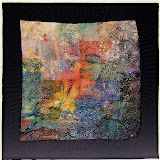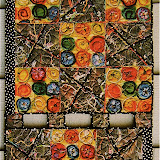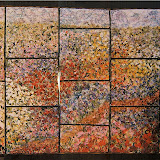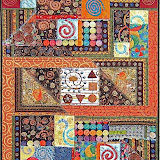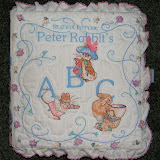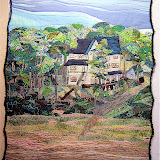Wednesday, October 29, 2008
Monday, October 27, 2008
Bird Perches & Headdresses
The two foreground birds were created just before I left the cottage. The orange one was done last spring when I first began. All of them got their perches this week after I got back to Tennessee.


To make the birds stand more easily and securely, I glue their feet to objects ... some to driftwood collected on the beach in Michigan and some to shells that I've found on past vacations.
I hope many of you are enjoying watching these birds come to life here on my blog as well as in your own studios and sewing rooms.
Sunday, October 26, 2008
Flock of Birds Getting Bigger
It isn't even noon and there have been nearly 200 visitors from the Netherlands to read about my birds. A member of an internet group posted this photo of her soooo cute birds on its site. I'm curious as to how the legs are constructed and what material(s) were used. The googly eyes are cute ... and I see the beaks were sewn on and shut rather than glued.
I'm curious as to how the legs are constructed and what material(s) were used. The googly eyes are cute ... and I see the beaks were sewn on and shut rather than glued.
Many people have downloaded my pattern which is a PDF file from HERE (note: while you're there, click on "more from this publisher" in the column on the right to access the downloadable instructions for constructing it). Two of them are college students in Colorado (one of which is the niece of cousin Judy) who made these two pretty birds. I'm so pleased to have found the Scribd site to post the pattern and instructions for these birds so that I could share them because it is impossible for anyone to download them from my blog. That site is free and it amazes me how many people have gone there:
I'm so pleased to have found the Scribd site to post the pattern and instructions for these birds so that I could share them because it is impossible for anyone to download them from my blog. That site is free and it amazes me how many people have gone there:
- 3, 046 for the pattern
- 2, 886 for the instructions
Thursday, October 16, 2008
Even More Birds
Making these birds is like eating peanuts ... I cannot stop. I keep finding new combinations of fabrics that will make wonderful birds.
"Sewing Bird" (below) has a body cut from pieced scraps given to me by my friend, Helen. The wings are made from fabric with sewing machines on it that I had begged from Elaine to make our guild's special award ribbon for "Best Machine Work". As a thank you to her for sending it (and more than I had asked for) this bird flew to her house earlier in the week.
Tuesday, October 14, 2008
Beautiful Fall Days on the Lake
Here are two very blue days with big cumulus clouds floating across the sky. They are much like most of days we experienced through September. This one is a calm day with strong reflections glaring off the water and sand.
 The skies for both of these are the "other side" of pieces cut from a blue silk blouse with roses scattered throughout. It was given to me by a friend ... she purchased #67. That same silk was used for the prairie flower pieces I made about a year ago. They can be seen here and here.
The skies for both of these are the "other side" of pieces cut from a blue silk blouse with roses scattered throughout. It was given to me by a friend ... she purchased #67. That same silk was used for the prairie flower pieces I made about a year ago. They can be seen here and here.
Thursday, October 09, 2008
Exciting Opportunity From One Of My Favorite Artists
I've previously written about Paula of the Self-taught Artist blog and her art. It was her work of a series of 100 clocks that enticed me to do the lake series. Speaking of clocks, Paula has especially created TEN fun clocks. One is to be auctioned on Ebay beginning this evening at 7PM. Her stated intent for this project is:
The point of the auction is mostly to allow blog fans to have first dibs. The point is also to allow people a chance to buy affordable contemporary functional art. I have made these clocks identical (as close as possible given the medium) which also keeps the price down as the level of creativity stays even instead of making a completely new piece each and every time.Go to Paula's blog to get details for Ebay so you can join the excitement of possibly getting a wonderful piece of art.
To view the piece of art that we purchased from Paula go here
Sunday, October 05, 2008
Creating Layered Borders
For this Smoky Mountain series I decided to keep the composition small (9"x 9"). To give the pieces substance as well as to emphasize the distance of the furthermost mountains they are framed with 2" wide borders.
 Also apply a spritz of spray adhesive to the top surface of the foundation fabric. Make a selection of decorative yarns that complement the composition. I chose two variegated chenille yarns plus one that is twisted with a finer thread and a decorative rayon one. Cut lengths and arrange them on top of the foundation.
Also apply a spritz of spray adhesive to the top surface of the foundation fabric. Make a selection of decorative yarns that complement the composition. I chose two variegated chenille yarns plus one that is twisted with a finer thread and a decorative rayon one. Cut lengths and arrange them on top of the foundation. Select a tulle netting that complements your choices and the composition for which the border is being created. I used black. Spritz a layer of adhesive to the underside of the tulle before carefully laying it in place. Pin baste all the layers together.
Select a tulle netting that complements your choices and the composition for which the border is being created. I used black. Spritz a layer of adhesive to the underside of the tulle before carefully laying it in place. Pin baste all the layers together. Machine stitch around the outside edges to secure the yarn ends. Run straight rows of stitching parallel to and between the rows of yarns.
Machine stitch around the outside edges to secure the yarn ends. Run straight rows of stitching parallel to and between the rows of yarns. I had used a metalic copper thread for that first set of stitches.
I had used a metalic copper thread for that first set of stitches. And then I couched rows of this twisted fiber yarn across the piece.
And then I couched rows of this twisted fiber yarn across the piece. To read the tutorial about the method I use for couching yarn go here. Scroll to the middle of that post for the instructions to couch yarn on a surface. The first part is about couching yarn to raw edges.
To read the tutorial about the method I use for couching yarn go here. Scroll to the middle of that post for the instructions to couch yarn on a surface. The first part is about couching yarn to raw edges. This is the result of couching that variegated twisted linen type yarn.
This is the result of couching that variegated twisted linen type yarn. My last step was to fill in any spaces with rows of a narrow zig-zag pattern using a #40 quilting thread.
My last step was to fill in any spaces with rows of a narrow zig-zag pattern using a #40 quilting thread. When you are satisfied with the amount of stitching trim one ragged edge from the layered border fabric. Measuring from this clean edge cut the fabric into four borders. For this small composition each of the borders are the same width. On some of my larger quilts the bottom border has been cut wider than the other three.
When you are satisfied with the amount of stitching trim one ragged edge from the layered border fabric. Measuring from this clean edge cut the fabric into four borders. For this small composition each of the borders are the same width. On some of my larger quilts the bottom border has been cut wider than the other three. Do not cut any length away from the borders. Align the edge of a border with the edge of the quilt. Apply scotch tape to keep the pieces together. Turn it right side up and stitch the two together with a wide zig-zag stitch.
Do not cut any length away from the borders. Align the edge of a border with the edge of the quilt. Apply scotch tape to keep the pieces together. Turn it right side up and stitch the two together with a wide zig-zag stitch. Apply the border on the opposite side of the quilt. Then zig-zag stitch the other two borders just to the sides of the quilt. All the corners will be overlapped and hanging loose.
Apply the border on the opposite side of the quilt. Then zig-zag stitch the other two borders just to the sides of the quilt. All the corners will be overlapped and hanging loose. My preference is to miter the corners of these borders. Although, they certainly could be finished otherwise. Use an acrylic ruler to draw the angle between the corner of the quilt and where the edge of two borders meet. For equal width borders this will be 45 degree line. It will be a different angle for two borders that are different widths. Cut along this line through both layers. It's easier to cut one layer and then draw on and cut the other. Tape and zig-zag stitch the miter closed.
My preference is to miter the corners of these borders. Although, they certainly could be finished otherwise. Use an acrylic ruler to draw the angle between the corner of the quilt and where the edge of two borders meet. For equal width borders this will be 45 degree line. It will be a different angle for two borders that are different widths. Cut along this line through both layers. It's easier to cut one layer and then draw on and cut the other. Tape and zig-zag stitch the miter closed. To finish the raw seam between the borders and the quilt I cover it with a flat decorative yarn. It is zig-zag stitched in place by machine. Do this before applying decorative yarns to those same seams on the front of the quilt.
To finish the raw seam between the borders and the quilt I cover it with a flat decorative yarn. It is zig-zag stitched in place by machine. Do this before applying decorative yarns to those same seams on the front of the quilt. Here's a close-up photo of the decorative yarns that finish the front side of the quilt. Use the first method described in my tutorial for couching yarns to apply it to the outside edge. Sometimes I cover the mitered corner seams with yarn. Doing so will draw attention to that detail. Omit that step if doesn't work for your quilt.
Here's a close-up photo of the decorative yarns that finish the front side of the quilt. Use the first method described in my tutorial for couching yarns to apply it to the outside edge. Sometimes I cover the mitered corner seams with yarn. Doing so will draw attention to that detail. Omit that step if doesn't work for your quilt. Here are links to other quilts that feature my layered fabric borders:
Here are links to other quilts that feature my layered fabric borders:Wednesday, October 01, 2008
Inspiration Comes Thru the Mail
ALL this wonderful inspiration arrived in my mail box the other day. These goodies came from Deb who was clearing excess "stuff" out of her studio.

I cut Deb's ball of rainbow rayon ribbon yarn into various lengths and tied it into this mutual project with which my young friend Katrina and I are playing.



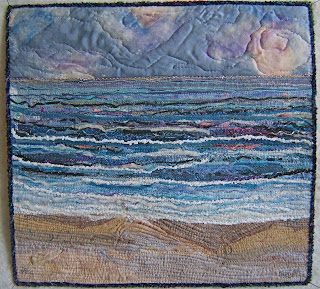




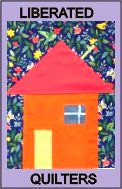 Fabric Bird Sculpture Pattern
Fabric Bird Sculpture Pattern




